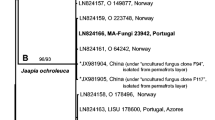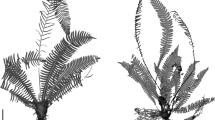Abstract
In Mycena sectio Calodontes with otherwise amyloid spores, the inamyloid spores of Mycena pearsoniana Dennis ex Singer were a distinguishing feature for this species and its subsection Violacella. Although the original concept of this species was European, Singer chose to typify it with material collected in Mexico. The name has since been applied to all European collections with inamyloid spores and decurrent lamellae. Our phylogenetic analysis of 91 ITS sequences from European, North and South American Calodontes collections shows that European collections identified as M. pearsoniana fall into two well-supported sibling clades together with both inamyloid and weakly amyloid North American collections. Since the holotype of M. pearsoniana is in an advanced state of decay, we have selected an epitype from a North American locality with a climate comparable to the Mexican type locality. Our results show weakly and inamyloid spore reactions to be homoplastic in Calodontes, and furthermore that spores of M. pearsoniana can show either amyloid or inamyloid reactions interchangeably. This raises doubt about the taxonomic value of this trait in Mycena systematics.



Similar content being viewed by others
References
Aronsen A, (2011) A key to the Mycenas of Norway. http://home.online.no/~araronse/Mycenakey/whatsnew.htm
Brown JKM, Hovmøller MS (2002) Aerial dispersal ofpathogens on the global and continental scales and itsimpact on plant disease. Science 297:537–541
Castresana J (2000) Selection of conserved blocks from multiple alignments for their use in phylogenetic analysis. Mol Biol Evol 17:540–552
Cooke MC (1892) Handbook of Australian fungi. Williams and Norgate, London
Dennis RWG (1970) Fungus flora of Venezuela and adjacent countries. Kew Bulletin Additional Series 3. Royal Botanic Gardens, Kew
Frøslev TG, Jeppesen TS, Læssøe T, Kjøller R (2007) Molecular phylogenetics and delimitation of species in Cortinarius section Calochroi (Basidiomycota, Agaricales) in Europe. Mol Phyl Evol 44:217–227
Gardes M, Bruns TD (1993) ITS primers with enhanced specificity for basidiomycetes – application to the identification of mycorrhizae and rusts. Mol Ecol 2:113–118
Gordon SA, Petersen RH (1997) Infraspecific variation among geographically separated collections of Marasmius androsaceus. Mycol Res 101:365–371
Gordon SA, Petersen RH (1998) Infraspecific variation among geographically separated collections of Marasmius scorodonius. Mycotaxon 69:453–466
Grand EA, Hughes KW, Petersen RH (2010) Relationships within Lentinus subg. Lentinus (Polyporales, Agaricomycetes), with emphasis on sects. Lentinus and Tigrini. Mycol Prog (in press)
Hall TA (1999) BioEdit: a user-friendly biological sequence alignment editor and analysis program for Windows 95/98/NT. Nucleic Acids Symp Ser 41:95–98
Harder CB, Læssøe T, Kjøller R, Frøslev TG (2010) A comparison between ITS phylogenetic relationships and morphological species recognition within Mycena sect. Calodontes in Northern Europe. Mycol Prog 9:395–405
Huelsenbeck JP, Ronquist F (2001) MRBAYES: Bayesian inference of phylogenetic trees. Bioinformatics 17:754–755
Hughes KW, Petersen RH, Mata JL, Psurtseva NV, Kovalenko AE, Morozova OV, Lickey EB, Cifuentes Blanco J, Lewis DP, Nagasawa E, Halling RE, Takehashi S, Aime MC, Bau T, Henkel T (2007) Megacollybia (Agaricales). Report of the Tottori Mycological Institute 45:1–57
Hughes KH, Petersen RH, Lickey EB (2009) Using heterozygosity to estimate a percentage DNA sequence similarity for environmental species’ delimitation across basidiomycete fungi. New Phytol 182:795–798
James TY, Porter D, Hamrick JL, Vilgalys R (1999) Evidence for limited intercontinental gene flow in the cosmopolitan mushroom, Schizophyllum commune. Evolution 53:1665–1677
Jargeat P, Martos F, Carriconde F, Moreau PA, Gryta H, Gardes M (2010) Phylogenetic species delimitation in ectomycorrhizal fungi and implications for barcoding: the case of the Tricholoma scalpturatum complex (Basidiomycota). Mol Ecol 19:5216–5320
Jin J-K, Hughes KW, Petersen RH (2001) Biogeographical patterns in Panellus stypticus. Mycologia 93:309–316
Josserand M, 1960(”1959”). Notes critiques sur quelques champignons de la région lyonnaise (6 ser.). Bull Soc Mycol Fr 75:359–404
Katoh K, Kuma K, Toh H, Miyata T (2005) MAFFT version 5: improvement in accuracy of multiple sequence alignment. Nucleic Acids Res 33:511–518. doi:10.1093/nar/gki198
Kornerup A, Wanscher JH (1978) Methuen handbook of colour, 3rd edn. Methuen, London
Kühner R (1938) Genre Mycena (Fries). Étude cytologique et systématique des espèces d’Europe et d’Amérique du Nord. Encyclopédie mycologique, vol 10. Paul Lechévalier, Paris
Liang JF, Xu J, Yang ZL (2009) Divergence, dispersal and recombination in Lepiota cristata from China. Fungal Divers 38:105–24
Lindner DL, Banik MT (2009) Effects of cloning and root-tip size on observations of fungal ITS sequences from Picea glauca roots. Mycologia 101:157–165
Maas Geesteranus RA (1980) A tentative subdivision of the genus Mycena in the northern hemisphere. Studies in Mycenas − 15. Persoonia 11:93–120
Maas Geesteranus RA (1989) Conspectus of the Mycenas of the Northern Hemisphere – 13. Sections Calamophilae and Calodontes. Proceedings of the Koninklijke Nederlandse Akademie van Wetenschappen 92(4):477–504
Matheny PB, Curtis JC, Hofstetter V, Aime MC, Moncalvo JM, Ge ZW, Yang ZL, Slot JC, Ammirati JF, Baroni TJ, Bougher NL, Hughes KW, Lodge DJ, Kerrigan RW, Seidl MT, Aanen DK, DeNitis M, Daniele GM, Desjarden DE, Kropp BR, Norvell LL, Parker A, Vellinga EC, Vilgalys R, Hibbett DS (2006) Major clades of Agaricales: a multi-locus phylogenetic overview. Mycologia 98:982–995
Nagarajan S, Singh DV (1990) Long distance dispersal of rust pathogens. Annu Rev Phytopathol 28:139–153
Nylander JAA 2004) MrModeltest v2. Program distributed by the author. Evolutionary Biology Centre, Uppsala University
Pearson AA (1955) Mycena. The Naturalist, April-June, 41–63
Pegler DN (1983) Agaric flora of the Lesser Antilles. Kew Bulletin, Additional Series IX. Royal Botanic Gardens, Kew
Pringle A, Adams RI, Cross HB, Bruns TD (2009) The ectomycorrhizal fungus Amanita phalloides was introduced and is expanding its range on the west coast of North America. Mol Ecol 18:817–833
Queloz V, Sieber TN, Holdenrieder O, McDonald B, Grünig CR (2011) No biogeographical pattern for a root-associated fungal species complex. Glob Ecol Biogeogr 20:160–169
Rambaut A, Drummond, AJ (2007) Tracer v1.4. http://evolve.zoo.ox.ac.uk/
Rexer KH (1994) Die Gattung Mycena s. l. - Studien zu ihrer Anatomie, Morphologie und Systematik. Dissertation, Universität Tübingen
Ridgway R (1912) Color Standards and Color Nomenclature. Washington, D.C., published privately (by the author)
Robich G (2003) Mycena d’Europa. A.M.B., Fondazione Centro Studi Micologici. Trento, Vicenza
Singer R (1959)"1958" Fungi mexicani, series secunda Agaricales. Sydowia 12:221–243
Smith AH (1947) North American species of Mycena. University of Michigan Press, Ann Arbor
Swofford DL (2003) PAUP*. Phylogenetic Analysis Using Parsimony (and Other Methods) Version 4.10. Sinauer, Sunderland, MA
Taylor AFS (2008) Recent advances in our understanding of fungal ecology. Coolia 51:197–212
Taylor JW, Jacobson DJ, Kroken S, Kasuga T, Geiser DM, Hibbett DS, Fisher MC (2000) Phylogenetic species recognition and species concepts in fungi. Fungal Genet Biol 31:21–32
Taylor JW, Turner E, Townsend JP, Dettman JR, Jacobson D (2006) Eukaryotic microbes, species recognition and the geographic limits of species: examples from the kingdom Fungi. Philos Trans R Soc Lond B 361:1947–1963
Vellinga EC, Wolfe BE, Pringle A (2009) Global patterns of ectomycorrhizal introductions. New Phytol 181:960–97\3
Vilgalys R, Sun BL (1994) Ancient and recent patterns of geographic speciation in the oyster mushroom Pleurotus revealed by phylogenetic analysis of ribosomal DNA sequences. Proc Nat Acad Sci USA 91:4599–4603
Wilgenbusch JC, Warren DL, Swofford DL (2004) AWTY: A system for graphical exploration of MCMC convergence in Bayesian phylogenetic inference. http://ceb.csit.fsu.edu/awt
Acknowledgements
We thank the curator of the LILOA herbarium in Argentina for loaning the holotype of M. pearsoniana for study. Collecting in the Great Smoky Mountain National Park was supported by US National Science Foundation grant DBI 6338699 to K.W. Hughes and R.H. Petersen at the University of Tennesse, Knoxville. C.B. Harder was supported by The Danish Council for Strategic Research grant (2104-08-0012, MIRESOWA) at the time of the writing. The authors thank B.A. Perry and the following pre-reviewers for valuable comments on previous versions of the manuscript: K. O’Donnell, J. Geml and D.E. Desjardin.
Author information
Authors and Affiliations
Corresponding author
Additional information
This paper was prepared by a US Government employee as part of their official duties and it is therefore in the public domain and not subject to copyright.
Rights and permissions
About this article
Cite this article
Harder, C.B., Lodge, D.J., Petersen, R.H. et al. Amyloidity is not diagnostic for species in the Mycena pearsoniana complex (Mycena sectio Calodontes) . Mycol Progress 11, 725–732 (2012). https://doi.org/10.1007/s11557-011-0782-x
Received:
Revised:
Accepted:
Published:
Issue Date:
DOI: https://doi.org/10.1007/s11557-011-0782-x




